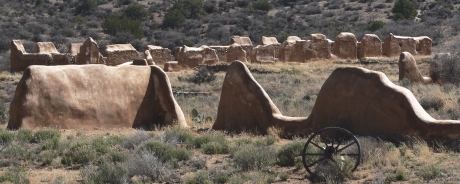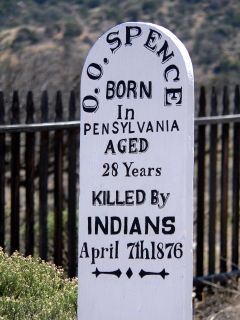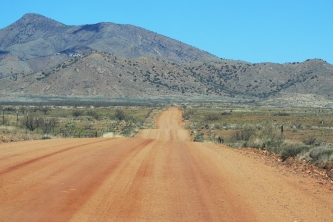NPS Website
 WHAT IS IT?
WHAT IS IT?Ruins of a large adobe U.S. Military Fort. Construction began on Fort Apache in 1862 with the purpose of protecting travelers from the hostile Chiricahua Apaches. The Fort became obsolete just 24 years later when the last Apache warrior, Geronimo, surrendered on these grounds.
BEAUTY (5/10)
Fort Bowie NHS is located in the stark, shadeless and rugged Arizona high desert. The 5,000 foot altitude creates a wide variation of temperature extremes. Shrub trees line the surrounding lands, not tall enough to be mountains but too large to be hills.
This is the landscape of the American western, nearby is Tombstone, Arizona, the site of the O.K. Corral. Only the land is more foreboding than its Hollywood body double and not as picturesque as the orange pinnacles of John Ford’s Monument Valley. This is a fearsome and inhospitable place.
The Fort Bowie ruins resemble a rusted adobe cemetery. Short remnants of the walls rise in an organized symmetrical fashion, looking like headstones and reminding one of its contentious past. None of the buildings have been reconstructed, nothing is as it once was.
HISTORICAL INTEREST (5/10)
Apache Spring runs near the ruins of Fort Bowie. This rare fresh water source in arid southeastern Arizona was vital to the Apaches during the thousands of years they inhabited the land. Throughout the 16th and 17th centuries, Indians successfully repelled Spanish conquistadores from the area.
By the mid-19th Century American pioneers were drawn to the area and the spring. The Apaches had co-existed with American pioneers largely because the land was too barren to inhabit. The Butterfield Overland Mail Route encountered few problems during its 1858-1861 operation. Nevertheless, tensions were high; there were rumors of gold. Then the Bascom Affair changed everything.
In January, 1861 a rogue band of Apaches raided the livestock of Arizona settler John Ward. Ward wrongly accused Apache leader Cochise of the crime. In February, under the guise of friendly negotiation, the U.S. Military lured Cochise into their camp and proceeded to hold him hostage until he released Ward’s stolen animals.
Cochise felt insulted, denied any involvement and dramatically escaped imprisonment, slashing his way through the tent encampment and riding through the army’s soldiers. 25 years of war ensued, necessitating the construction of Fort Bowie.
Initially, soldiers coming from the west to fight in the Civil War needed protection. After the Civil War ended, the U.S. Military poured more resources into controlling the West and removing the Native Americans. The Apaches finally surrendered in 1886 and were moved to a reservation. The Apaches were the last Indian tribe to surrender in the southern United States.
Fort Bowie NHS marks a surrender and American military triumph just as significant as those finalized at Appomattox, Fort Laramie and San Jacinto. The British surrender at Yorktown is, of course, the most significant domestic American victory.
The Park site, however, does not characterize Geronimo’s surrender at Fort Bowie as the end game in a bloody domestic war, one that solidified American control and facilitated territorial settlement and ownership. Instead, Fort Bowie NHS tells stories of skirmishes and frontier military life. It downplays the Site’s significance and the serious and vital consequences of the Apache Wars in our nation’s history.
 CROWDS (6/10)
CROWDS (6/10)The ruins of Fort Bowie, as well as the Visitor Center, are a mile and a half hike from the Site’s parking lot. As a result, few people visit the Site and even less actually make it to the trail’s end. We arrived on a busy, beautiful and mild holiday weekend. The Site had a relatively large crowd, about 50 people.
EASE OF USE/ACCESS (1/5)
This Site is much more inaccessible than the Rand McNally lets on. Fort Bowie NHS’s parking lot is located just off Apache Pass Road. Most of Apache Pass Road is unpaved.
From the north, the parking lot is 12 miles south of Interstate 10, the Bowie exit. We were warned that this portion of dirt road is especially treacherous. We avoided it. Instead, exited Interstate 10 at Willcox, drove 22 miles southeast along Arizona Route 186 and then 6 miles northeast (on unpaved Apache Pass Road) to the parking lot.
We say parking lot because no road leads to either Fort Bowie NHS or its Visitor Center. The Site is accessed by 1½ mile path that moves up a slight incline. There is little shade along the way, making the trail a bit unappealing in the 110º summer heat.
CONCESSIONS/BOOKSTORE (3/5)
Fort Bowie NHS’s book titles tend toward the esoteric. Nearly all of its 60+ historical books relate directly to the incidents that happened in this specific southeastern Arizona area. Geronimo, Mangas Coloradas, Cochise and military officers who served here are the subjects of many of the titles. The books do not even stray to explain the cowboy lore of nearby Tombstone.
The specificity of the Site’s selection is understandable and appreciated given that whatever you buy you have to lug back out.
COSTS (4/5)
Fort Bowie is 100%, absolutely, sure-as-the-sky-is-blue free.
RANGER/GUIDE TO TOURIST RATIO (2/5)
Be patient. There are no Rangers at the trailhead or posted along the trail to explain the Butterfield Overland Mail Route, the Stage Coach station ruins, the Apache Pass Battle Site, the frontier cemetery or the ruins of the first Fort Bowie.
There is a Ranger at the Visitor Center, which lies at the end of the trail. Save your questions and exercise your memory skills. We pulled the Ranger out of his office to ask questions but at other times he was standing on the Visitor Center’s front porch.
TOURS/CLASSES (3/10)
Pick up the park pamphlet in the parking lot and read it well. It is your only introduction to the Fort. Assorted exhibit panels line places in the trail where action occurred. There is no film at the Visitor Center and no Ranger talks. The small Museum displays original memorabilia but does not delve into any in depth historical discussion or analysis. The dearth of educational opportunity may be commensurate with the Site’s small crowds but Fort Bowie’s events and their players deserve better.
FUN (3/10)
Fort Bowie NHS was more bothersome than fun. The history is interesting, but the Park refuses to reach any definitive conclusions. Cochise, Mangas Coloradas and Geronimo are all wildly fascinating characters in American history but the Site only superficially examines them.
The extreme summer heat and the harsh winters make a visit hard to fit in. We happened on a perfect day in early March, but had to bypass the Site last November because it was too cold. The Site is 120 miles east of Tucson, making it day trip-able for only a small number. The hike was nice but we would have appreciated more info on what we were walking past.
 WOULD WE RECOMMEND? (3/10)
WOULD WE RECOMMEND? (3/10)Fort Bowie NHS is very close to Chiricahua NM. If you are visiting its astounding rock pillars, you might want to come to Fort Bowie to take a history-related day hike. If you are chasing the memory of the Wild West in nearby Tombstone, a trip to Fort Bowie NHS would provide a good historical context.
Before you drive miles down a dirt road, ask yourself: "Are the ruins of a western fort worth the trouble of a three-mile round trip hike?"
TOTAL 35/80
www.usa-c2c.com
© 2004-06